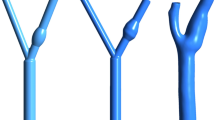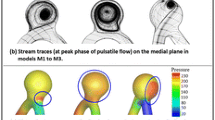Abstract
The effects of the bifurcation angle on the steady flow structure in a straight terminal aneurysm model with asymmetric outflow through the branches have been characterized quantitatively in terms of laser-Doppler velocimetry (LDV)-measured mean velocity and fluctuating intensity distributions. The bifurcation angles investigated were 60°, 90°, and 140° and the Reynolds number based on the bulk average velocity and diameter of the afferent vessel was 500. It is found that the size of the recirculating zones in the afferent vessel, the flow activity (both mean and fluctuating motions) inside the aneurysm, and the shear stresses acting on the aneurysmal wall increase with increasing bifurcation angle. More importantly, both LDV-measured and flow-visualized results of the present study suggest the presence of a critical bifurcation angle below which the aneurysm is susceptible to thrombosis, whereas above this the aneurysm is prone to progression or rupture.
Similar content being viewed by others
Abbreviations
- a :
-
aneurysm height
- b :
-
distance from orifice to fundus
- c :
-
orifice diameter
- D :
-
afferent conduit diameter
- d :
-
fundus diameter
- Hz :
-
frequency unit = cycle/second
- L :
-
length of bifurcation zone
- Re :
-
Reynolds number = U · D/v
- U :
-
streamwise mean velocity
- U m :
-
streamwise bulk mean velocity
- u′ :
-
streamwise fluctuating component
- X * :
-
normalized streamwise coordinate: X * ≥ 0: X * = X/a; X * <0: X * = X/L
- Y * :
-
normalized transverse coordinate: Y * = Y/D
- Z * :
-
normalized spanwise coordinate: Z * = Z/D
- ν :
-
kinematic viscosity
- θ b :
-
angle of bifurcation
- θ c :
-
critical bifurcation angle
References
Ferguson, G. G. 1970: Turbulence in human intracranial saccular aneurysms. J Neurosurg. 33, 485–497
Ferguson, G. G. 1972: Physical factor in the initiation, growth, and rupture of human intracranial saccular aneurysms. J. Neurosurg. 37, 666–677
Kerber, C. W.; Heilman, C. B. 1983: Flow in experimental berry aneurysms: method and model. AJNR 4, 374–377
Perktold, K.; Peter, R.; Resch, M. 1989: Pulsatile non-Newtonian blood flow simulation through a bifurcation with an aneurysm. Biorheology 26, 1011–1030
Roach, M. R.; Scott, S.; Ferguson, G. G. 1972: The hemodynamic importance of the geometry of bifurcations in the circle of Willis (Glass Model Studies). Stroke 3, 255–267
Steiger, H. J.; Reulen, H.-J. 1986: Low frequency flow fluctuations in saccular aneurysms. Acta Neurochir. 83, 131–137
Steiger, H. J.; Poll, A.; Liepsch, D.; Reulen, H.-J. 1987: Basic flow structure in saccular aneurysms: a flow visualization study. Heart and Vessels 3, 55–65
Steiger, H. J.; Poll, A.; Liepsch, D.: Reulen, H.-J. 1988: Hemodynamic stress in terminal aneurysms. Acta Neurochir. 93, 18–23
Author information
Authors and Affiliations
Rights and permissions
About this article
Cite this article
Liou, T.M., Chang, T.W. & Chang, W.C. Effects of the bifurcation angle on the steady flow structure in model saccular aneurysms. Experiments in Fluids 14, 289–295 (1993). https://doi.org/10.1007/BF00189486
Received:
Issue Date:
DOI: https://doi.org/10.1007/BF00189486




